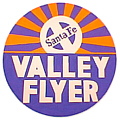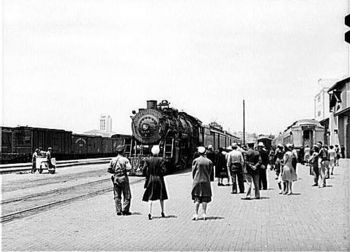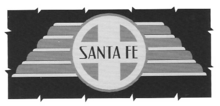Valley Flyer

The Valley Flyer was a short-lived, named passenger train of the Atchison, Topeka and Santa Fe Railway.
The all-heavyweight, "semi-streamlined" train operated between Bakersfield and Oakland, California (through the heart of California's San Joaquin Valley, hence the name) during the 1939–1940 Golden Gate International Exposition, located on "Treasure Island" in San Francisco Bay. Motive power consisted of a pair of aging, Baldwin-built 1300 class type 4-6-2 "Pacific" steam-powered locomotives refurbished and specially-decorated for the train. It was the Santa Fe's first attempt at streamlining older steam power. The units alternated service.
The locomotives had metal skirting applied along the sides, which was painted aluminum (as was the nose and smokestack) with red and yellow stripes, these being oultined by black pinstripes; the tenders were similarly decorated. A yellow "Circle and Cross" emblem backed by red "wings" was emblazoned across the front of the locomotive above the pilot deck, and on each side of the tender, which also featured a red "wing." The air-conditioned rolling stock was painted completely in aluminum, and had red and yellow stripes running along their sills, bordered with black pinstripes (somewhat akin to those found on Santa Fe's passenger diesel locomotives). Stripes on the combine unit spilt into two sets, with one set sweeping up to align with those on the locomotive tenders. Window shades were painted matte aluminum. The sides of the passenger cars bore the words "SANTA FE" in black, extra extended Railroad Roman letters. The design of the Valley Flyer's drumhead was inspired by that of its counterpart, the Golden Gate.
Operation commenced on June 11, 1939. The train left Bakersfield daily at 6:30 a.m. and arrived in Oakland at 12:35 p.m., then returned south at 1:55 p.m., pulling into Bakersfield station at 8:00 p.m. Beginning on October 27, 1941 the Flyer (save for the lounge car) was used to transport troops as a section of the San Diegan on the Santa Fe's "Surf Line" run between Los Angeles and San Diego. In 1942, the trainset was discontinued and the passenger cars returned to pool service and repainted Coach Green.
Equipment used
- Baldwin 4-6-2 Pacific #1369
- Baldwin 4-6-2 Pacific #1376
- Combine Baggage-Barbershop-Buffet-Library #1302
- Lounge #1367
- Fred Harvey Company Diner #1467
- "Chair" car / Coach #3002
- "Chair" car / Coach #3005
- "Chair" car / Coach #3006
References
- Duke, Donald and Stan Kistler (1963). Santa Fe...Steel Rails through California. Golden West Books, San Marino, CA.
- Duke, Donald (1997). Santa Fe...The Railroad Gateway to the American West, Volume 1. Golden West Books, San Marino, CA. ISBN 0-87095-110-6.
- Hendrickson, Richard H. (1998). Santa Fe Railway Painting and Lettering Guide for Model Railroaders, Volume 1: Rolling Stock. The Santa Fe Railway Historical and Modeling Society, Inc., Highlands Ranch, CO.
- McGonigal, Robert S., ed. (2005). "Semi-streamlined steam stars." Streamliner Pioneers 51.
- Pelouze, Richard W. (1997). Trademarks of the Santa Fe Railway. The Santa Fe Railway Historical and Modeling Society, Inc., Highlands Ranch, CO.
See also
- Passenger train service on the Atchison, Topeka and Santa Fe Railway


